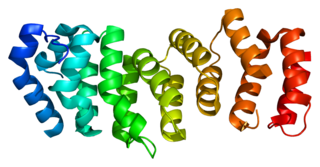26S proteasome complex subunit DSS1 is a protein that in humans is encoded by the SHFM1 gene. [3] [4] [5]
26S proteasome complex subunit DSS1 is a protein that in humans is encoded by the SHFM1 gene. [3] [4] [5]
The product of this gene has been localized within the split hand/split foot malformation locus SHFM1 at chromosome 7. It has been proposed to be a candidate gene for the autosomal dominant form of the heterogeneous limb developmental disorder split hand/split foot malformation type 1. In addition, it has been shown to directly interact with BRCA2. It also may play a role in the completion of the cell cycle. [5]

The centromere is the specialized DNA sequence of a chromosome that links a pair of sister chromatids. During mitosis, spindle fibers attach to the centromere via the kinetochore. Centromeres were first thought to be genetic loci that direct the behavior of chromosomes.
Heterochromatin is a tightly packed form of DNA or condensed DNA, which comes in multiple varieties. These varieties lie on a continuum between the two extremes of constitutive heterochromatin and facultative heterochromatin. Both play a role in the expression of genes. Because it is tightly packed, it was thought to be inaccessible to polymerases and therefore not transcribed, however according to Volpe et al. (2002), and many other papers since, much of this DNA is in fact transcribed, but it is continuously turned over via RNA-induced transcriptional silencing (RITS). Recent studies with electron microscopy and OsO4 staining reveal that the dense packing is not due to the chromatin.

Ectrodactyly–ectodermal dysplasia–cleft syndrome, or EEC, and also referred to as EEC syndrome and split hand–split foot–ectodermal dysplasia–cleft syndrome is a rare form of ectodermal dysplasia, an autosomal dominant disorder inherited as a genetic trait. EEC is characterized by the triad of ectrodactyly, ectodermal dysplasia, and facial clefts. Other features noted in association with EEC include vesicoureteral reflux, recurrent urinary tract infections, obstruction of the nasolacrimal duct, decreased pigmentation of the hair and skin, missing or abnormal teeth, enamel hypoplasia, absent punctae in the lower eyelids, photophobia, occasional cognitive impairment and kidney anomalies, and conductive hearing loss.

Serine/threonine-protein kinase ATR also known as ataxia telangiectasia and Rad3-related protein (ATR) or FRAP-related protein 1 (FRP1) is an enzyme that, in humans, is encoded by the ATR gene. It is a large kinase of about 301.66 kDa. ATR belongs to the phosphatidylinositol 3-kinase-related kinase protein family. ATR is activated in response to single strand breaks, and works with ATM to ensure genome integrity.

Double-strand break repair protein MRE11 is an enzyme that in humans is encoded by the MRE11 gene. The gene has been designated MRE11A to distinguish it from the pseudogene MRE11B that is nowadays named MRE11P1.

Transcription factor E2F4 is a protein that in humans is encoded by the E2F4 gene.

Tumor suppressor p53-binding protein 1 also known as p53-binding protein 1 or 53BP1 is a protein that in humans is encoded by the TP53BP1 gene.

Fanconi anemia group D2 protein is a protein that in humans is encoded by the FANCD2 gene. The Fanconi anemia complementation group (FANC) currently includes FANCA, FANCB, FANCC, FANCD1, FANCD2, FANCE, FANCF, FANCG, FANCI, FANCJ, FANCL, FANCM, FANCN and FANCO.

Krev interaction trapped protein 1 is a protein that in humans is encoded by the CCM1 gene. This gene contains 16 coding exons and is located on chromosome 7q21.2. Loss of function mutations in CCM1 result in the onset of Cerebral cavernous malformation. Cerebral cavernous malformations (CCMs) are vascular malformations in the brain and spinal cord made of dilated capillary vessels.

Homeobox protein DLX-5 is a protein that in humans is encoded by the distal-less homeobox 5 gene, or DLX5 gene. DLX5 is a member of DLX gene family.

Fanconi anemia group J protein is a protein that in humans is encoded by the BRCA1-interacting protein 1 (BRIP1) gene.

Fanconi anemia, complementation group E protein is a protein that in humans is encoded by the FANCE gene. The Fanconi anemia complementation group (FANC) currently includes FANCA, FANCB, FANCC, FANCD1, FANCD2, FANCE, FANCF, FANCG, and FANCL. Fanconi anemia is a genetically heterogeneous recessive disorder characterized by cytogenetic instability, hypersensitivity to DNA cross-linking agents, increased chromosomal breakage, and defective DNA repair. The members of the Fanconi anemia complementation group do not share sequence similarity; they are related by their assembly into a common nuclear protein complex. This gene encodes the protein for complementation groufcrp E.

AP-1 complex subunit sigma-2 is a protein that in humans is encoded by the AP1S2 gene.

F-box/WD repeat-containing protein 4 is a protein that in humans is encoded by the FBXW4 gene.

Homeobox protein DLX-6 is a protein that in humans is encoded by the DLX6 gene.

Split hand/foot malformation (ectrodactyly) type 3 pseudogene 1, also known as SHFM3P1, is a human gene.

Transcription factor LBX1 is a protein that in humans is encoded by the LBX1 gene.

Oligodactyly is the presence of fewer than five fingers or toes on a hand or foot.

In molecular biology, the DSS1/SEM1 protein family is a family of short acidic proteins which includes the 26S proteasome complex subunits SEM1 from Saccharomyces cerevisiae and Drosophila and DSS1 (SHFM1) in mammals. In Saccharomyces cerevisiae, SEM1 is a regulator of both exocyst function and pseudohyphal differentiation. Loss of DSS1 in Homo sapiens (human) has been associated with split hand/split foot malformations. DSS1 is playing role as a modifier in a novel protein posttranslational modification, referred to as DSSylation, which is probably targeting oxidized proteins and guiding them to proteasomal degradation.

Ectrodactyly, split hand, or cleft hand involves the deficiency or absence of one or more central digits of the hand or foot and is also known as split hand/split foot malformation (SHFM). The hands and feet of people with ectrodactyly (ectrodactyls) are often described as "claw-like" and may include only the thumb and one finger with similar abnormalities of the feet.